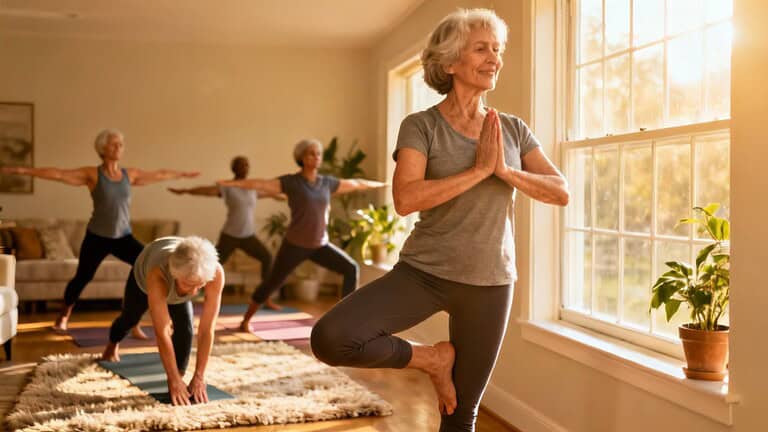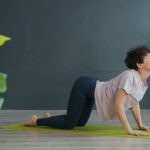What if one simple practice could cut your fall risk in half—without requiring a gym, trainer, or even leaving your living room?
For people over 50, falls aren’t just accidents; they’re often the turning point that changes everything from confidence to independence. The statistics are sobering: one in four Americans aged 65 and older fall each year.
But here’s the empowering truth: you can retrain your body and brain to balance better. Not with extreme workouts or complicated machines, but with five simple, graceful movements rooted in yoga and functional training.
This isn’t about flexibility or touching your toes—it’s about staying on your feet, keeping your freedom, and aging with control.
Move 1: Tree Pose – Your First Line of Defense
You don’t need to climb a mountain to gain balance; sometimes you just need to stand like a tree. Tree Pose might look calm and still, but inside it’s a full-body wakeup call that challenges your ankles, knees, hips, and most importantly, your mind’s ability to stay steady under pressure.
Studies show that single-leg balance exercises like Tree Pose can significantly cut fall risk when practiced regularly. More than just strength, this pose trains proprioception—your body’s ability to sense where it is in space. That skill fades with age, but the good news is it’s trainable.
How to Do Tree Pose
- Stand tall with feet hip-width apart near a wall or sturdy chair if needed
- Shift your weight to your left foot
- Bring your right foot to rest on your inner left calf or thigh—never on the knee
- Bring hands to prayer position or raise them overhead
- Hold for 10 to 30 seconds, breathing deeply
- Switch sides and repeat
Tip: Wobbling is part of the magic; each tiny adjustment builds strength. If you have hip or ankle issues, try the same pose with your toes lightly touching the floor like a kickstand.
Move 2: Warrior 2 – Balance Through Grounded Strength
Aging may soften the body, but Warrior 2 reminds it how to stand firm. This pose looks like a wide-legged lunge with arms stretched out, but beneath the surface, it’s a powerful tool for retraining your body’s internal balance system—especially the lateral plane where most real-life falls happen.
Unlike standing still, Warrior 2 teaches your body to balance while in motion—as you reach, twist, or shift weight, just like in daily life: stepping off a curb, turning to pick up a bag, or reacting to a slip.
How to Do Warrior 2
- Start standing, then step your feet about 3 to 4 feet apart
- Turn your right foot out 90 degrees, back foot angled slightly in
- Bend your right knee directly over the ankle; left leg stays straight
- Extend both arms out at shoulder height, palms down
- Gaze over your right hand
- Hold for 20 to 30 seconds, then switch sides
Tip: Keep your shoulders relaxed and imagine energy reaching out through both fingertips. If you have knee issues, modify by narrowing your stance or placing a chair under the front thigh for support.
Move 3: Forward Fold – Balance Begins With Letting Go
As we age, stiffness becomes the silent thief of balance. Tight hamstrings, locked hips, and a rigid lower back all limit how quickly we can react when we trip or shift unexpectedly. Forward Fold helps undo that tension and restore the body’s natural reflexes.
This pose gently shifts your center of gravity forward, teaching your body how to adapt and stabilize in unfamiliar positions, like leaning over to tie your shoe or pick up something from the floor.
It’s also deeply calming, engaging the parasympathetic nervous system—the one that tells your body, “You’re safe. You’ve got this.”
How to Do Forward Fold
- Stand tall with feet hip-width apart
- On an exhale, hinge at your hips and slowly fold forward
- Let your head and arms hang freely, knees slightly bent
- Hands can rest on shins, blocks, or the floor
- Breathe deeply and hold for 20 to 30 seconds
- To rise, engage your core and roll up slowly
Tip: Don’t force the stretch; gravity is doing the work. If you have spinal issues, modify by placing hands on a chair seat instead of reaching toward the floor.
Move 4: Bird Dog – Core Control Meets Cross-Body Balance
True stability starts at the core and spine—the body’s control tower. Bird Dog strengthens that center while challenging your ability to coordinate opposite sides of the body, a skill your brain uses every time you walk, reach, or recover from a stumble.
This cross-body coordination fades faster than most people realize. That’s why Bird Dog is used in neurological rehab, physical therapy, and senior fall prevention programs across the U.S. It doesn’t just train muscles; it retrains movement patterns.
How to Do Bird Dog
- Start on all fours—wrists under shoulders, knees under hips
- Engage your core; imagine pulling your belly up toward your spine
- Extend your right arm forward and your left leg back, keeping hips level
- Hold for 5 to 10 seconds, then slowly return to start
- Repeat on the other side
- Do 5 to 8 controlled reps per side
Tip: Focus more on control than height; slow, steady movement is key. If you have wrist pain, try performing it with just the arm or just the leg, not both at once.
Move 5: Single Leg Romanian Deadlift – Train for the Fall That Never Happens
Most falls don’t happen because someone slips; they happen because they can’t recover the moment after. That moment—the split second your body tries to catch itself—is exactly what this move trains.
The Single Leg Romanian Deadlift mimics real-life situations: bending forward to pick something up, stepping awkwardly on uneven ground, turning quickly with groceries in hand.
It strengthens your posterior chain—the hamstrings, glutes, and lower back—while demanding micro-adjustments in the ankle, foot, and hip.
How to Do Single Leg Romanian Deadlift
- Stand tall with feet hip-width apart
- Shift weight to your left foot
- Hinge at the hips as you slowly lift your right leg back and lower your upper body forward
- Keep your back straight and your arms hanging or reaching forward
- When your torso is parallel to the floor or as far as comfortable, pause, then slowly return to standing
- Repeat 5 to 8 reps per leg
Tip: Lightly touch a wall or chair with your fingertips if you feel wobbly. If you have poor ankle stability, keep the back foot on the ground as a kickstand for support.
Stronger Balance, One Simple Move at a Time
If you’ve made it this far, you are already doing what most people never even consider: investing in your future mobility—not just by hoping, but by training for it. These five movements may look gentle, even quiet, but their impact is anything but small.
Each one speaks directly to a part of your body that time often forgets: ankles, hips, spine, reflexes, and even the brain’s internal GPS.
They’re not just yoga poses or balance drills; they are everyday insurance policies against the kind of falls that change lives.
And here’s what most people miss: it’s never too late to improve. Neuroplasticity, muscle control, proprioception—all of it can be rebuilt. Not perfectly, maybe, but meaningfully, powerfully.
So whether you’re just starting or restarting, these movements are here for you. You can do them in a chair, near a wall, or with a loved one. You can wobble, breathe, try again, and still win. You don’t need to move fast; just don’t stop moving.








